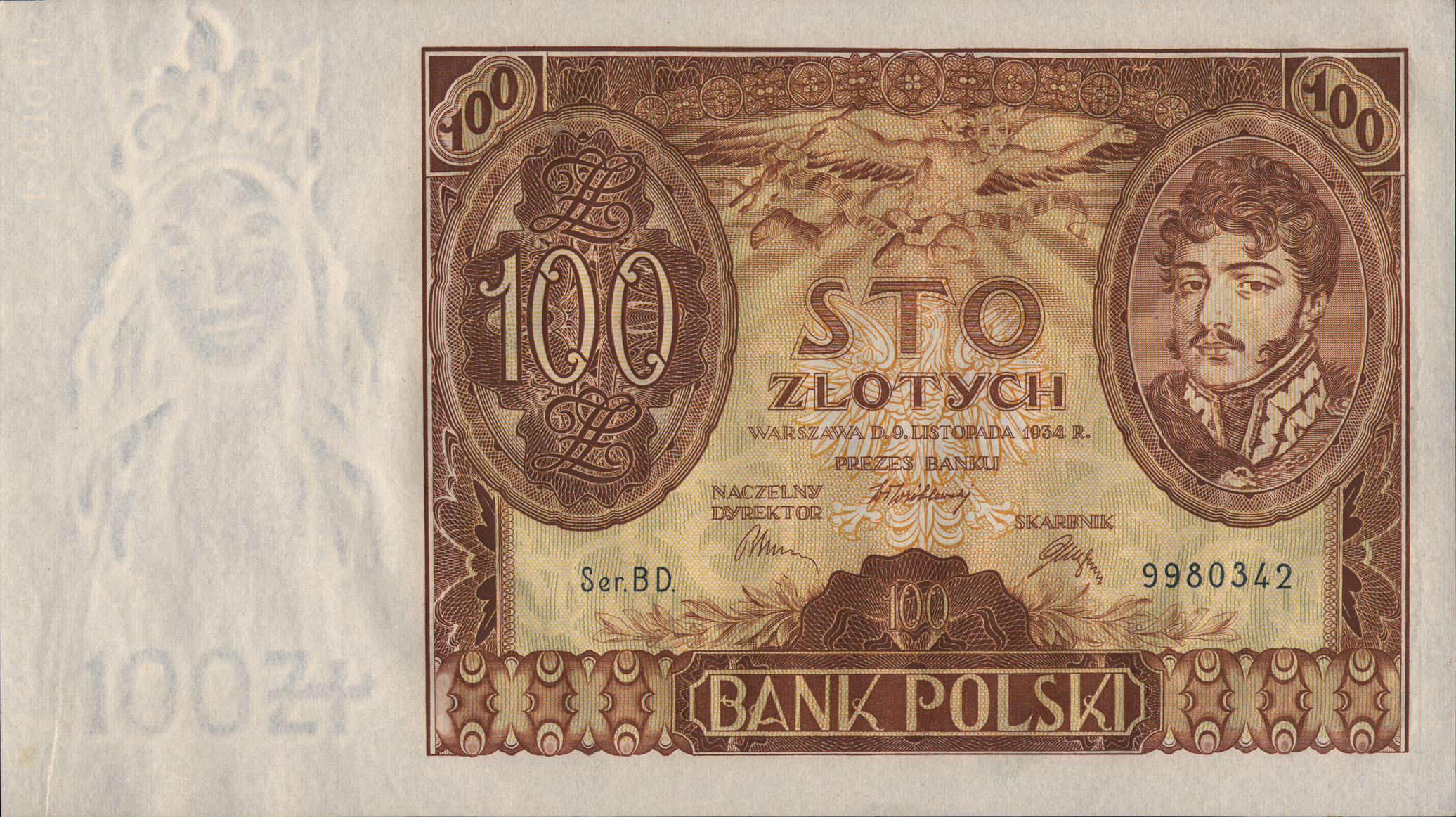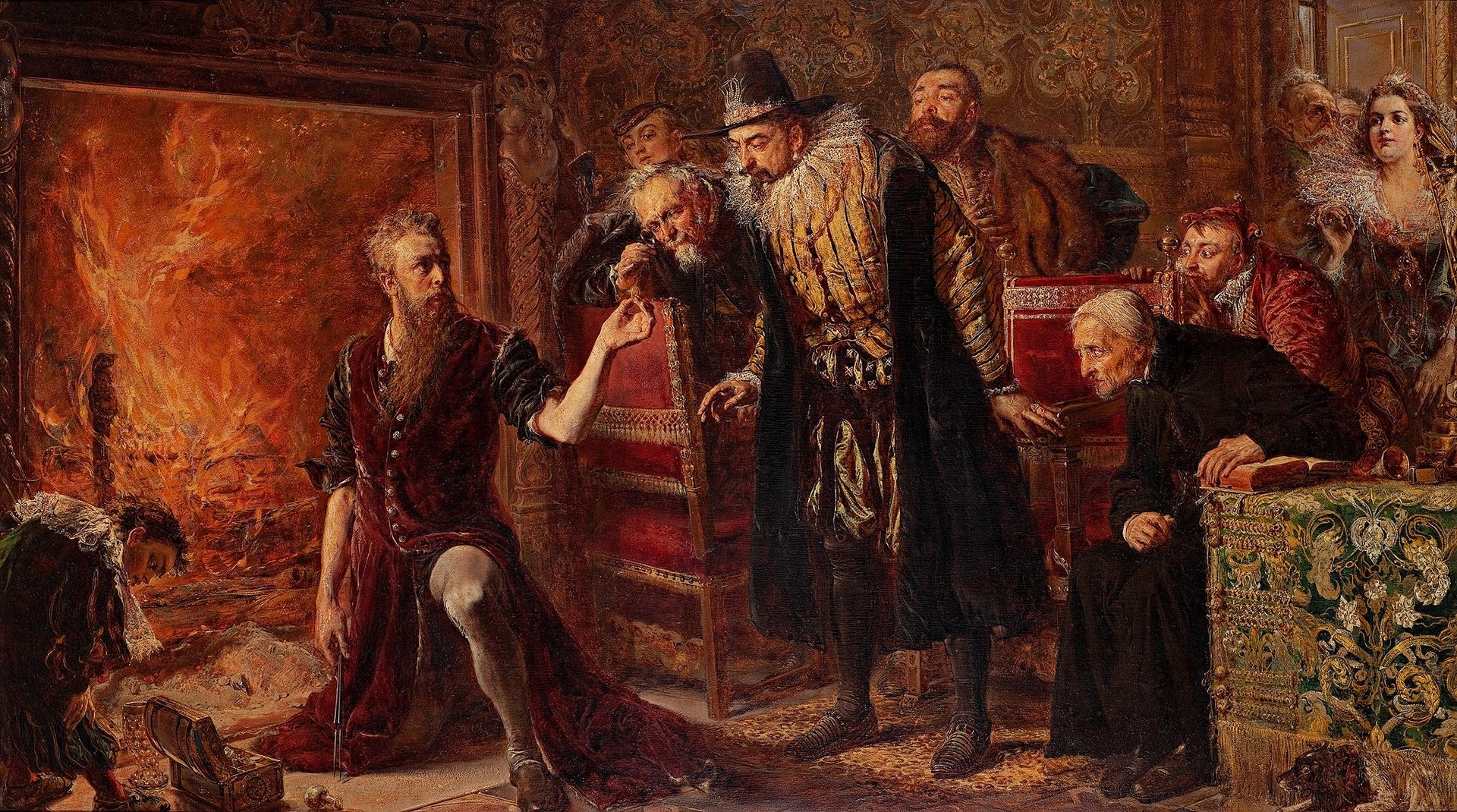In 1916, it was the third year of the Great War, and there was no end in sight to the military struggle. All sides of the conflict were looking for new allies, although it was not so much about gaining more political supporters as it was about, above all, gaining more soldiers. For soldiers were in increasingly short supply every week as the war dragged on. Poland, which was to regain independence only in November 1918, owes its first currency to this ongoing state of war.
by Andrzej Zawistowski
In 1915, Germans and Austrians occupied quite large areas of Russia largely inhabited by non-Russian people, including potential soldiers. However, according to international law, these areas constituted an occupied area, which, among other things, meant that conscription could not be organized there.
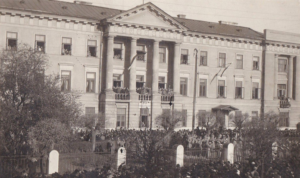
It would be a different situation altogether if “independent” states were to develop in these lands and, after establishing their armed forces, felt like supporting the Central Powers! This was the concept behind the declaration issued in November 1916 by the Emperors German Wilhelm II and Austrian Franz Joseph. On its basis, the Kingdom of Poland was created. It was true that it was a kingdom without a king, and even without any borders, but it was still able to establish its own army. Paradoxically, however, this decision necessitated the formation of an official structure of administration for this puppet state which on 11 November 1918 would be taken over by the emerging Polish state. One of the results of this new nation’s official structure was a Polish currency.
Before Poland was born
Problems with the circulation of money in the territories occupied by the Central Powers of the Russian partition had appeared earlier. According to the Hague Convention of 1907, the occupier should try to preserve the pre-war monetary system in the occupied lands. This was to protect civilians from rapid impoverishment. In the case of the Polish territories of the former Russian partition, this meant keeping the Russian ruble in circulation. But it was not that simple – the issuing institutions were located in Petrograd which was cut off by the front. Therefore, in 1916, Germany began issuing ostrubles – a currency put into circulation in the areas from which the Russian army had been ousted. That is why, when the aforementioned Kingdom of Poland was created, it made sense for it to produce its own currency. A Polish State Loan Bank was established in Warsaw, which was completely controlled by the Germans, and it began issuing the Polish Mark, which was subdivided into 100 pfennig. The name of this currency directly alluded to the German Mark, illustrating Kingdom of Poland’s dependence on the German Empire.
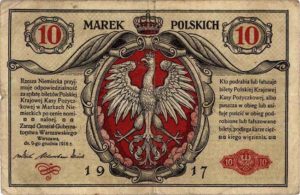
Meanwhile, in the nascent Polish Republic
The Polish Mark introduced by the occupiers in December 1918 formally became the currency of the new independent Polish state. What’s more, it circulated not only within the former lands of the Russian Partition, but also in areas incorporated into Poland from the territories of Germany and Austria. At the end of 1922, one could pay with Polish Marks in Wilno, Katowice, Warsaw, Lwów and Poznań, i.e. cities before the war that were part of three different countries. This wartime makeshift currency solution turned out to be extremely durable.
This does not mean, however, that Poland was not thinking about introducing its own currency. It was necessary for many reasons: economic and political ones, but also for the purpose of propaganda. It was necessary to help the state build public confidence and integrate society. Moreover, banknotes and coins were a way to propagate statehood. Therefore, as early as 1919, efforts to introduce another new currency were undertaken. Before even the first 100 days had passed since Poland proclaimed independence, Chief of State Józef Piłsudski issued a decree regarding the new Polish currency which was to be called the Lech. Its hundredth part was to be a grosz and the issuer was to be the specially created Bank of Poland.

The proposed name did not find support among the new elected members of parliament. Less than three weeks later, they changed the name to Zloty. This was the name of the unit of account in the Polish-Lithuanian Commonwealth, and from the 17th century there had been Zloty coins in circulation. Banknotes denominated in Zloty were issued during the Kościuszko Uprising; it was the first Polish paper money. In the 19th-century Kingdom of Poland, coins denominated in Zlotys were in circulation, and in 1830 banknotes were also issued. In 1841, the Russians withdrew the Zloty, replacing it with the Ruble. It was one of the repressive decisions enacted as part of the suppression of the November Insurrection. The decision of the Polish parliament taken in 1919 to restore the name of the currency liquidated by the invader was therefore highly symbolic.
Shortly after the decision of the Sejm, the printing of these new zloty-denominated banknotes started in Switzerland. However, instead of into Poles’ wallets, they went to the treasury to await the construction of a completely new monetary system. Circumstances were not favorable, as the construction of a new state, and above all the war over its borders, required enormous expenditures. When the government was short of money, printing machines were brought into play and new banknotes were issued. Of course, this led to inflation, however, it was the price that had to be paid for the defense of Poland’s independence. In this situation, there was no point in introducing a new currency.
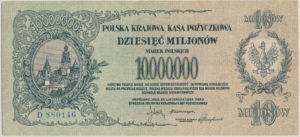
Inflation and hyperinflation
When the fighting ceased and the borders formalized, it became time to normalize monetary policy. However, decisions were delayed yet again. For some time, inflation had been tolerated by the authorities because the young economy benefited from it and exporters benefited from the low prices of goods produced in Poland. Inflation was also favorable for national trade – those willing to shop, feared increases and thus did not postpone their decision until later. In turn, such market behavior stimulated production and increased employment. Over time, however, inflation grew out of control, turning into hyperinflation. In this situation, the positives no longer outweighed the negatives. In August 1923, a 10 million Polish Mark banknote came into circulation. In March 1924, this was equivalent to one dollar – in November 1918 its value had fluctuated around 8-10 Marks. Not only did the currency system require reform, but also the treasury was half-empty. Tax rates were ridiculously low, with some taxpayers evading their obligations, and inflowing funds quickly losing their value. In November 1923, 33 trillion Polish Marks were missing from the treasury and 74% of the government’s expenditure was covered with empty money, rapidly fueling the hyperinflation.
It required many socially unpopular decisions in order to stabilize the situation, especially regarding taxes. No government or political party was ready for such measures. Meanwhile, hyperinflation was taking its toll on Poland’s economic and political life. Prices were out of control (in October 1923 they increased by 360 percent), and there were empty shelves in the stores. Real wages were falling – they were slightly higher than in the last year of the Great War and social discontent was growing. In 1921, there were 720 strikes in Poland, while in hyper-inflationary Poland in 1923 there were 1273 such protests. In November 1923, a general strike took place in Krakow, which was bloodily suppressed by the army and police. This action by the government caused a shock; until recently the soldiers had been the heroes who had saved Poland from the Bolsheviks, now they were shooting at civilians and being shot by them too. These events led to the resignation of the government of Wincenty Witos, who had previously served as Prime Minister during the Polish-Bolshevik war.
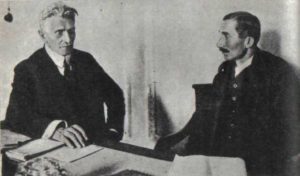
Poland also suffered an embarrassment on the international stage for its delays in rescuing the currency with radical measures. When, after the First World War, the Free City of Gdańsk was created by Treaty of Versailles, it was incorporated into the customs territory of the Polish state. The consequence of this was the decision to create the Polish-Gdańsk monetary union and an appropriate agreement was even signed on this matter but never formalized. Time passed, however, and no agreement materialized. Meanwhile, the currency that was valid in Gdańsk (known as the Mark and closely related to the German Mark) experienced the disastrous effects of Germany’s post-war hyperinflation. Therefore, Gdańsk asked Poland to end the planned monetary union – it was no longer possible to wait for an intervention. The union was dissolved in September 1923, and at the beginning of the following year Gulden appeared in circulation in the Free City of Gdańsk.
At that time, a major battle with hyperinflation began in Poland.
Grabski’s government
In view of the failure of party policy, it was decided to entrust the Prime Minister’s office with someone from outside the current political dispute. A government of professionals was to be established for which the main task would be to organize the country’s economy. In the end, the choice fell on Władysław Grabski.
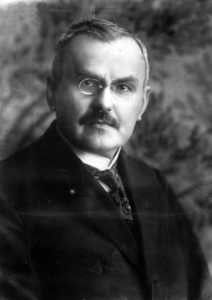
He was not a new person on the political scene as in 1920, he had briefly been Prime Minister. However, he had greater experience as the Minister of the Treasury responsible for the finances of the state. In the previous four years, he had held five offices. In the government established in December 1923, in addition to the Prime Minister’s office, Grabski also took responsibility for the Ministry of Treasury. At the same time, for half a year, parliament gave him the opportunity to issue decrees with the force of law. By removing these decisions from the political area, this significantly accelerated the enactment of the desired legal solutions. The race against time had begun as each week of delay was bringing measurable losses to both the state budget and its citizens.
The road to normalization proposed by Władysław Grabski had two stages. The first was fiscal reform and balancing of the budget. These actions were to remove the causes of hyperinflation. The second stage was currency reform, i.e. the elimination of the effects of hyperinflation in the national currency. If the situation had not been so dramatic, these stages could have been introduced sequentially. At the end of 1923, however, there was no time for this – both reforms had to be carried out simultaneously.
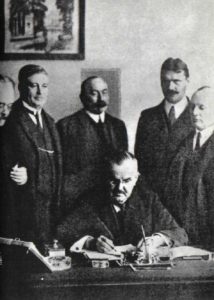
In January 1924, regulations accelerating the payment of taxes owed to the state came to light. Next came a series of increases in direct taxes (February-June 1924) and property tax (June 1924). The property tax introduced in August 1923, which was levied on the richest, was enforced. State revenues were also to be provided by new fiscal monopolies in the spirits, salt and matches. Grabski not only increased budget revenues, but also reduced expenses. The funds allocated to railway co-financing and for the army were reduced. The number of state administration employees was also reduced and almost 30,000 were laid off. All these activities had a direct affect on health of the state budget, although it was still running a 10% deficit.
In parallel with the work on tax reforms, a currency reform was prepared. Even though Grabski managed to stabilize the Polish Mark’s exchange rate, preparations for the introduction of the Zloty were underway. It should not be forgotten that for almost five years those new banknotes had been waiting in the treasury. Although there was a problem standing in the way of their issue, not only did the name of the new currency (i.e. Zloty) appear on them, but also the name of the issuer: Bank of Poland. The problem was that this bank had yet to be established.
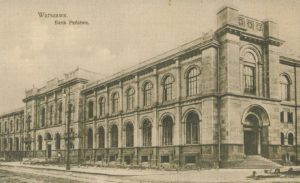
It was decided to follow the recommendation of an international conference, which was held in 1922 in Genoa, and which stated that issuing banks should be independent of state authorities. This was to protect them from the pressure of rulers who might want to force the bank to increase its emissions. Therefore, the Bank of Poland was established as a joint-stock company and its shares went to 176 000 shareholders; the treasury held only 1 percent of shares. In this way, the foundation of an independent Polish bank was established. At the end of April 1924, the Bank of Poland began issuing the Zloty – only the banknotes – and minting was left to the government. The Zloty was a currency based on gold parity – its value was determined at 9/31 grams of pure gold. One dollar was equal to 5.18 Zloty, which at that time made the Polish currency equal to the Swiss franc. For several weeks, the Polish Mark and Zloty functioned side by side. At the same time, the old currency was being withdrawn from circulation and replaced with the new currency. One Zloty could be obtained for 1.8 million Polish Marks. On 1 July 1924, the Polish Mark ceased to be a legal means of payment, although it could still be exchanged at the bank for a new currency. In total, 196 million banknotes of Marks were withdrawn from circulation.
Over the next months, Prime Minister Władysław Grabski struggled to fully balance the budget. When the banking crisis occurred in the autumn of 1925, the Prime Minister demanded that the president of the Bank of Poland intervene in the currency market. The president refused – after all, he headed an institution independent of the government. This conflict led to Grabski’s resignation, and the institution he created led to the collapse of his office. Paradoxically, it is difficult to get a better summary of the success of Grabski’s reforms; he managed to create an institution that defended itself from political pressure from above.
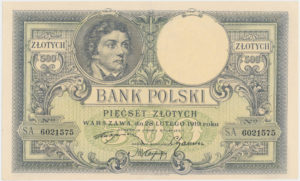
Ultimately, the Zloty stabilized at a level lower by about 40 percent from that in the spring of 1924. It is worth noting that Grabski carried out the entire operation only on the basis of Poland’s resources. Other countries in which a similar operation was carried out at the same time benefited from international support. Poland could not take this path – the expected price for such support was consent to the strengthening of Germany’s international position by Great Britain. This, in turn, would open talks on the revision of the Polish Western border, which was unacceptable for Warsaw. Fortunately, this was not necessary and six years after regaining its independence, the Polish Republic finally had its own currency.
Author: Andrzej Zawistowski
Translation: Alicja Rose & Jessica Sirotin

